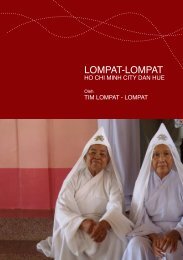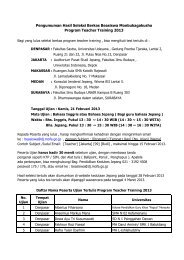9700_y16_sy
9700_y16_sy
9700_y16_sy
You also want an ePaper? Increase the reach of your titles
YUMPU automatically turns print PDFs into web optimized ePapers that Google loves.
Cambridge International AS and A Level Biology <strong>9700</strong> <strong>sy</strong>llabus Practical assessment<br />
• Decide and describe how the dependent variable has been measured to obtain accurate and precise<br />
results<br />
Candidates should:<br />
– Use a variety of techniques to measure dependent variables, including release of gases; absorption<br />
of gases; change in colour (using an indicator for change in pH); time (to a colour change when<br />
testing for biological molecules); counting (e.g. cells showing degrees of plasmolysis)<br />
– Decide on the frequency of measurement (e.g. measurements to determine the initial rate of a<br />
reaction should be taken as quickly as possible after the reaction starts)<br />
– Decide how long to allow for taking measurements to determine a rate of reaction, time for a colour<br />
change or time for a reaction to reach an end-point<br />
– Decide whether to repeat or replicate readings in order to identify anomalous results or to provide a<br />
more accurate estimate<br />
– Decide an appropriate number of significant figures for measurements or clear descriptions of<br />
observations<br />
– Decide how to measure an area using a grid, counting those areas covering half or more of a grid<br />
square as one whole square and not counting those areas less than half a square.<br />
Successfully collecting data and observations<br />
Within an investigation, candidates should be able to:<br />
• Follow instructions or diagrams using a range of techniques to collect results<br />
• Assess the risk of a procedure as low, medium or high using the hazards of solutions and reagents and<br />
the procedure<br />
• Take readings using a range of apparatus to obtain accurate data or observations with the expected<br />
pattern of results:<br />
– Quantitative results<br />
○ measure all results to an appropriate number of significant figures, using a range of apparatus<br />
which includes temperature changes with time; distance with time; time for a colour change;<br />
angle of bend; volumes of gases or solutions<br />
○ measure using counting: tally counts, e.g. to count bubbles in a minute; grids for surface area;<br />
numbers of cells<br />
– Qualitative results from observations of colour changes, using clear descriptions, for example:<br />
○ ‘blue’ or ‘orange’ or ‘purple’ with use of ‘pale’ or ‘dark’ for fine discrimination<br />
○ a number scale 1 to 5 for intensity of colour with a key<br />
○ a suitable <strong>sy</strong>mbol such as + or to represent cloudiness or intensity of colour (a key should<br />
always be given).<br />
Back to contents page<br />
www.cie.org.uk/alevel<br />
51





